
The Role of Roof Ventilation in Florida’s Hot, Humid Climate
Living in Florida means dealing with intense sun, high humidity, and long stretches of warm weather. While most homeowners focus on choosing the right roofing material or color, there’s another key factor that has a major impact on comfort, energy costs, and roof longevity: proper roof ventilation.
Roof ventilation is the system of allowing fresh air to flow in and hot, moist air to escape through your attic. When done correctly, it helps keep your roof cooler, protects your home from moisture damage, and supports your HVAC system — which is especially crucial in Florida’s demanding climate.
Why Roof Ventilation Matters in Florida
Florida’s weather patterns are different from most of the country. Our homes have to handle:
High heat for most of the year
Daily humidity
Heavy seasonal rainfall
Tropical storm conditions
Without proper ventilation, heat and moisture build up in the attic, creating stress that can lead to:
Higher electric bills
Mold and mildew growth
Warping or rotting wood
Shortened roof lifespan
Premature shingle deterioration
Heat Buildup: A Hidden Energy Drain
On a typical summer day, roof surfaces in Florida can reach 150°F or more. Without ventilation, that heat transfers into your attic — and then into your living spaces. Your air conditioning must work overtime to cool the home, resulting in higher energy bills and added wear on your HVAC system.
Proper ventilation reduces attic temperatures and helps your home stay cooler naturally, lowering your cooling costs and energy usage.
Humidity and Moisture Control
Humidity is one of the biggest challenges for Florida homeowners. Moisture trapped in the attic can lead to:
Mold growth
Musty odors
Condensation damage
Insulation breakdown
Ventilation allows damp air to escape rather than settle in wood structures or insulation. This keeps your attic dry and protects your home’s structural integrity.
Extending the Life of Your Roof
Excess heat and moisture are the two main factors that shorten the lifespan of roofing materials. By maintaining a balanced attic climate:
Shingles stay cooler and last longer
Wood framework remains strong and dry
Roof warranties remain valid (many require ventilation)
It’s a small investment that delivers long-term protection.
Signs Your Roof May Have Poor Ventilation
If you’ve noticed any of the following, your ventilation system may need attention:
Rooms that feel hotter near the ceiling
High summer energy bills
Curling or brittle shingles
Condensation or damp insulation in the attic
Musty smell from attic or upper floors
A quick roof and attic inspection can determine the best steps to improve airflow.
Professional Ventilation Solutions in Florida
The right ventilation system depends on your roof’s structure, materials, and design. Solutions may include:
Ridge vents
Soffit intake vents
Attic fans
Gable vents
Passive exhaust ventilation systems
A roofing professional can recommend a balanced setup that improves airflow without compromising weather protection.
Final Thought
In Florida’s hot and humid climate, roof ventilation isn’t just a bonus — it’s essential. Proper airflow keeps your home cooler, healthier, and more efficient, while protecting your roof investment for years to come.
If you’re experiencing high energy costs, roof wear, or moisture issues, a ventilation assessment may be one of the smartest upgrades you can make.
Call today for a free inspection and estimate — and keep your home covered, rain or shine.
Five Star Roofing & Construction is your experienced Best Roofing Contractors in Florida, offering Storm Damage Roof Repair and Flat Roof Repair throughout Tampa Bay, Pinellas County, Clearwater, Tampa, and Orlando for over 20 years. We are a Licensed, Bonded, and Insured Florida Contractor, and happily offer Free Roof Inspections and Roof Assessments.
This content is for general reading purposes only and is not intended as legal or professional advice.


